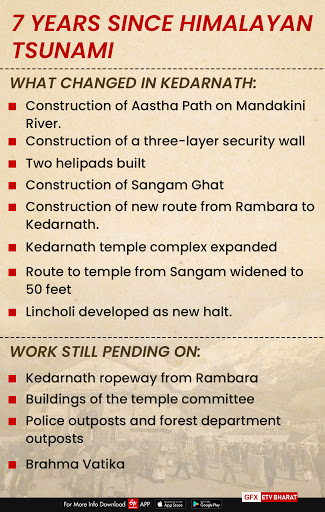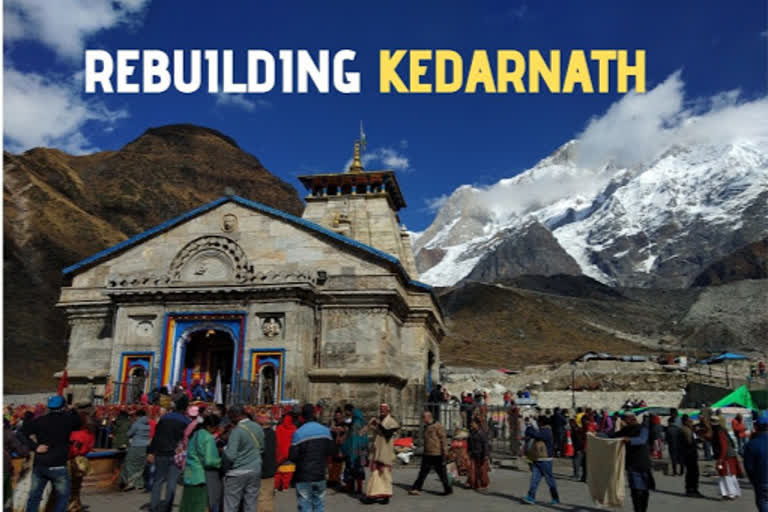Dehradun (Uttarakhand): June 16, 2013 is recorded as a dark day in Uttarakhand's history, as it was on this day that flash floods hit the Kedarnath valley, claiming over 4,000 lives.
Though the valley was ravaged by the deluge, seven years later, reconstruction work is on and is considered among Prime Minister Narendra Modi's dream projects.
At present, the shrine of Adi Guru Shankaracharya, damaged houses of priests and other basic facilities are being rapidly constructed, which is expected to be completed by the end of this year.
Reconstruction of Shankaracharya's Samadhi Sthal

The reconstruction work at the Samadhi Sthal of Adi Guru Shankaracharya is currently underway, as it was slowed down by the lockdown. It is now expected that the reconstruction would be completed by December 31. At present, the foundation has been built and work is underway to build the upper part of the structure.
Construction of damaged houses
Large-scale construction work is being executed in the Kedarnath Valley, but the residences of the priests have not been completed so far. While two blocks have been constructed, the remaining is expected to be completed soon.
Arrangements for passengers
Currently, three meditation caves are under construction. Along with this, the state government is also arranging facilities for the devotees on the banks of the Mandakini river to ensure that they do not face problems during rain and snowfall. Besides, arrangements will also be made for shopkeepers near the Mandakini embankment.
Interpretation Centre at Kedarnath Valley
Construction of the Saraswati bridge in Kedarnath valley has already been completed, which will make it easier for devotees to visit the Bhairav temple. Along with this, bathing ghats are being constructed at Saraswati Ghat.
Read: Galwan face-off: Army steps up vigil along China border in Uttarakhand
However, the administrative block, hospital, museum and interpretation centre is still to be constructed in the valley. Once constructed, the interpretation centre will provide complete information about the reconstruction work done following the 2013 disaster.
Challenges in the reconstruction
Due to the disaster in 2013, the economy of the state was completely destroyed. Besides, the state sits in zone IV and V making it prone to earthquakes and landslides. Security agencies have identified more than 200 highly sensitive landslide zones in the state.
Due to change in the weather, excessive rainfall during the monsoon has also become a norm. At the same time, new lakes are also being formed in the higher Himalayan region due to melting of glaciers, thus increasing the risk of sudden floods in the future.
Steps taken by Uttarakhand Government
Doppler radars are being installed at two places to warn the state of any future disasters. Radars are being installed in Mussoorie in Garhwal division and Mukteshwar in Kumaon. The radars will be able to provide information about heavy rain, hailstorm two hours in advance. The radar will also record data of activities occurring within a radius of 100 km.
Along with this, weather centres have been established in Uttarakhand, besides an earthquake warning system.
Destruction caused in 2013:
- According to government figures, more than 4,400 people were killed and went missing.
- Connection with more than 4,200 villages was lost.
- 991 locals were killed at different places.
- More than 11,000 cattle were swept away or buried under debris.
- 1,300 hectares of land had been washed away.
- In Kedarnath Valley, 2,141 buildings were demolished.
- More than 100 hotels were demolished.
- The army rescued 90,000 pilgrims from Kedarnath Valley.
- The Rescue teams rescued 30,000 locals to safer places.
- 9 national and 35 state highways were damaged during the disaster.
- During the 2013 disaster, 2,385 roads were damaged.
- 86 motor bridges and 172 bridges were washed away in the disaster.
Read: ITBP jawans intensify training amid ongoing China tension



